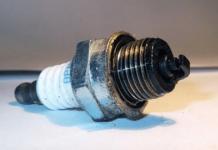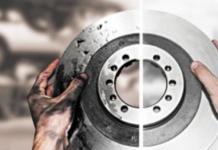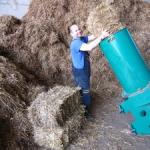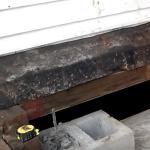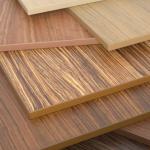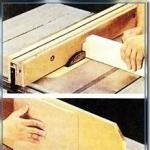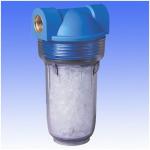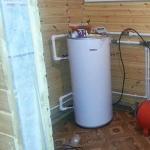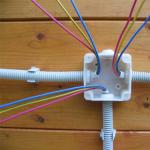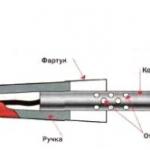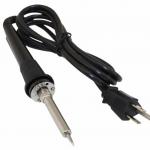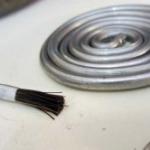Farmers are gradually moving away from manual labor. Owners in small private backyards are actively introducing small-scale mechanization to increase labor productivity. Such means include a straw chopper. Similar factory-made devices are commercially available, but it is not always advisable to purchase them due to their high cost. The fact is that the chopper device is extremely simple, and you can make it yourself.
Working principle and standard model
Explanations on the purpose of the chopper are unnecessary for those farmers who keep livestock. In addition, the device can be used for the production of fuel briquettes from hay or straw at home.
Manually chop the right amount of material for livestock feed is an extremely labor-intensive event in terms of time and effort. And you should not even think about the production of fuel briquettes in this way.
Some masters make handicraft shredders from the minimum set of improvised materials. Usually, old vacuum cleaners or pumps are used, in which the electric motor is working.
Tools of this type are easy to manufacture, but their productivity is extremely low. It is only enough to prepare food for ten rabbits. A larger farm requires more raw materials.
As a result, you need a reliable straw chopper for private backyards, which you can do yourself. Power should also be at a level that will allow the device to work for up to several hours without stopping.
Description of the typical design
A typical design implies the elements from which the device is made. Their minimum set can be supplemented by an auxiliary one. The goal is to improve the comfort of working with the device.

Standard chopper set:
- The bunker is a container of sufficient volume. Usually they take an old barrel or a large can, where the processed vegetation is laid.
- The electric motor is installed at the bottom of the bunker. The main thing is that its power is sufficient to work non-stop and for heavy loads.
- An axis on which knives are fixed in an amount from 3 to 6. It is fixed directly to the axis of the electric motor.
The basis of the device is a hopper with sharp knives, which are rigidly fixed on a steel disk. The disk is mounted on an axis, which is the shaft of the electric motor or is connected to it through a gearbox.
The bunker is a container for laying material - hay or straw, which require grinding. It is the cutting process. For safety reasons, the hopper is made as high as possible so that when loading raw materials, hands do not touch the knives. The shape of the container is usually cylindrical, but you can find the shape of an inverted cone. Set the container on a stand, usually in the form of a tripod. The height of the stand is such that an electric motor can be installed below. The latter is fixed on the bottom.
Sometimes the bunker is made small in height, but with a lid for safety reasons. The lid must have a hole for loading raw materials.
Production according to the flow principle is created by installing a waste mass dump. Through the device, the crushed material is ejected from the hopper. This allows you to add raw materials continuously. That is, stopping the motor to get a cut and add raw materials is not required. This results in significant time savings. It will be made from the bottom of the bunker. The shape is not important, the main thing is that there is a slope for the material dump.
A disk with knives placed on it is an extremely difficult part to manufacture. The design can be arbitrary. The goal during assembly is to achieve maximum balance so that the device does not shake from vibrations during operation.
Scheme of work

The container is usually a plastic barrel. It is advisable to cover it with a lid, and make a hole on the side so that the cut does not scatter in all directions. The operator only needs to feed the raw material and release the container with the cut in time. Ideally, several are used, changing as they fill.
Materials and manufacturing process
The manufacture of a house grinder begins with a drawing on paper. This allows you to have a visual representation of the design and identify shortcomings or refine important nuances at the design stage. Reworking the finished product will turn out to be more expensive, and extra time will be spent.
Assembly materials:

The electric motor is the main part of the device, which defines its characteristics. Choose a motor depending on the volume of the hopper for the straw chopper. The greater the mass of raw materials at one load, the more powerful the engine is required. Usually, an electric motor with a power of 2.2 to 6 kW is installed on a hay and straw chopper for private farmsteads. The speed of revolutions should not exceed 2 thousand / min for safety reasons. Optimal - 1.5 thousand / min.
An electric motor with a rotation speed higher than optimal can also be adapted for installation in a structure, but it is not connected directly to the shaft. For this use a reduction gear, often belt. You can use gear. The reduction gear allows you to increase the output from the motor and chop root crops and even small branches.
The motor is connected to the shaft on which the disk with knives will be installed. A tube can act as a shaft, but only a straight one, without distortions. This is necessary for proper balance, otherwise vibration will occur, which is unacceptable.
The knives are mounted on the shaft so that there is a minimum distance between them and the counterblades. This will ensure high-quality grinding of raw materials.
Device assembly
It is necessary to assemble with high quality, adjusting the details. The service life and safety of a household straw chopper depends on the quality of the assembly. The device contains moving parts and loose connections may come loose during operation. This is fraught with injury to the operator.

Assembly order:
- They work with the container and install an electric motor on it. In the absence of a bottom in the bunker, it is welded. A bracket and a metal plate are installed from below, where the electric motor is attached. The plate is fixed with a tank, and the engine is attached to it.
- Above the motor, inclined supports are installed, which will serve as a bracket for installing an unloading device. It is mounted in the place where the supports are connected to the edge of the bunker.
- Attach the motor with screws or bolts. The axis of the motor must be located above the inclined supports.
- Form a cutting tool. For this, pieces of high-quality carbon steel are suitable, which can be taken from the spent blade of a metal-cutting machine. The disk is taken in such a size that the installed knives on it do not touch the walls of the bunker.
- A disk with knives is fixed on a vertical axis. The axle can be made from a durable steel pipe. The main requirement is that the pipe be flat, without bends, as they will provoke vibration, which will affect the reliability of the device and its safety. The axis with knives is mounted on the motor shaft.
- Install a cover on the hopper, which will increase the safety of the device.
The finished product is placed on a stand, which is fixed on the floor. A do-it-yourself straw chopper is desirable to paint. This will prevent its corrosion, and the device will last a long time.
Hay from a do-it-yourself home crusher is in no way inferior in quality to products from a factory-made device. It only takes check the condition of the knives. The power of a home-made apparatus is enough not only for making chopped hay or straw, but also for chopping fresh grass. Such food is useful for livestock, because it is easier for them to chew. Dry straw can be used to make fuel briquettes for personal use and for sale. It will pay for the device.
Independent work on the machine, even with a new motor, will be cheaper than buying a finished one in a store. The market is flooded with Chinese products, the quality of which is questionable. And shredders of European manufacturers are expensive and not suitable for small farms.
Villagers and farmers often use different mechanisms to make their work easier. Such devices include a straw chopper. Such equipment can be found in the store, or you can make a crusher with your own hands, while saving a lot of money.
Purpose of the device
 Straw and hay are the main food for livestock during the cold season. Also, this material is used as flooring, for mulching the ground, for the production of fuel briquettes, etc. Therefore, many owners of private farms are forced to harvest hay in fairly large volumes. A hay chopper makes this task very easy.
Straw and hay are the main food for livestock during the cold season. Also, this material is used as flooring, for mulching the ground, for the production of fuel briquettes, etc. Therefore, many owners of private farms are forced to harvest hay in fairly large volumes. A hay chopper makes this task very easy.
Such equipment may have different sizes and power ratings. The operation of the device is provided rotating knives. Straw is sent to a special compartment. Being processed in the cutting drum, the material is crushed and fed into the return tank.
Design features
Hay grinders can be different. The standard design consists of the following items:
- Electric drive. The speed of processing depends on the power of the part.
- A tank where raw materials (straw or hay) are fed. Its dimensions may vary.
- Shaft with cutting parts. These elements must be made of strong steel.
- Compartment for recycled material. For convenience, it is installed at a slight slope.
- Supports. Often made from thick pipes. The height depends on the size of the engine.
Various elements can be additionally built into the chopper. But to perform basic tasks, the basic configuration is quite enough.
Popular Models
If you do not want to spend time and effort on creating such equipment, it is better to buy a finished device in a specialized store. most popular and reliable models in the domestic market are the following:
- M15. The device is equipped with a very convenient container for supplying raw materials. Engine power - 3 kW. This allows you to process even thin branches. The weight of the equipment is 130 kilograms.
- KP02. Very compact device with high performance. Electric drive power - 1.54 kW. This is enough to process 20 kilograms of straw in one hour. The model is convenient because it is powered by a standard 220 V power supply.
- K-500. A very powerful device that can grind up to 300 kilograms of hay per hour. Such equipment is great for large farms. Raw materials can be loaded directly into the bunker with forks, which significantly speeds up and facilitates the work.
 When choosing one system or another, take into account the volume of raw materials that needs to be processed. In the presence of a small number of livestock, it is not advisable to buy high-capacity equipment. In this case, it is better to save money and purchase a more compact shredder.
When choosing one system or another, take into account the volume of raw materials that needs to be processed. In the presence of a small number of livestock, it is not advisable to buy high-capacity equipment. In this case, it is better to save money and purchase a more compact shredder.
It is necessary to choose a product exclusively from proven manufacturers. Poor-quality equipment will not process straw well and will quickly become unusable.
A simple constructive device and the absence of complex mechanisms allow, if you have the skills and desire, to make a hay crusher with your own hands. It is enough to buy a powerful engine, and all additional parts can be found in any household.
How to DIY
If you do not have the desire or funds to buy a "store" chopper, then you can make it yourself. For this purpose, it is sufficient to adhere to the following course of action:

If you have experience in operating equipment for welding and understanding the principle of operation of the electric drive, you can make a hay and straw chopper with your own hands in a few hours. If there are some doubts about the success of such an undertaking, then it is better to go to the store and buy a device that is completely ready for use.
A hay cutter or a straw cutter is an indispensable unit in the subsidiary farm. With it, you can quickly and easily grind hay for poultry or young animals, as well as grind straw for warming beds or winter roads, making briquettes for heating. It is not difficult to make a hay chopper on your own, and the practicality and functionality of a home-made device will not be inferior to store-bought counterparts.
Hay chopper device
The simplest hay and straw chopper is made from a conventional vacuum cleaner. An ordinary plastic or aluminum bucket serves as a working chamber where raw materials are laid, and then a knife is lowered, mounted on a rotating shaft. You can make such a device in a few minutes, but it has one significant drawback: low productivity and impracticality. If the number of poultry or livestock is large, you will need a more reliable hay crusher.
The working unit is the most important part of the straw chopper. It consists of a steel bunker, inside of which there are knives. The knives are attached to the engine axis with a special axis. Usually the bunker is made in the form of a cylinder, and for greater safety, the walls are left high. You can do it with short walls, but then equip the device with a lid.

The main components of the straw chopper:
- Working chamber with lid
- Support,
- Motor,
- gain strip,
- Knives or cutting disc,
- Raw material receiver.
materials
A do-it-yourself hay cutter is assembled at home from materials available to everyone. And its manufacture does not require special technical skills. To make a hay chopper with your own hands, you need to have a locksmith kit, a welding machine, a drill and a grinding machine. From the materials you need:
- Motor (an electric motor from a washing machine is suitable),
- Sheet of metal, with a thickness of about two millimeters,
- Sheet of metal, about three millimeters thick,
- Steel sheet, ten millimeters thick,
- Pipe cut (do not use a diameter of more than 25 mm),
- A strip of metal, 3 mm wide, 25 mm long.
Manufacturing
Instead of knives, you can take a disk from a circular saw or a powerful food processor. A barrel or a piece of pipe with a diameter of at least thirty centimeters is well suited for the role of the body of the device.

Before you make a straw chopper with your own hands, it is advisable to find clear and detailed drawings of the apparatus on the Internet. They will prevent errors in the location of parts and fastening. Manufacturing begins with marking and cutting the workpiece from a pipe cut. An additional bottom is attached to the resulting container by welding, and already to it - a holder for the motor. Several holes are pre-drilled in the steel sheet to simplify the process of mounting the motor. A do-it-yourself straw cutter made from a pipe will turn out to be stronger if metal corners-kerchiefs are welded to the sides. A container for an already crushed product is attached below. Only after that the engine is installed. It is attached to a steel sheet, and cutting knives or discs are mounted on the axis and securely fixed. 
The last moment: an electrical cable and a toggle switch are mounted, as well as a cover and an indicator light. The device is ready to work.
A simpler and less powerful do-it-yourself hay chopper can be made from an ordinary washing machine. In addition to the machine, you also need:
- Knives or cutting disc,
- electric wire,
- bucket,
- metal corner,
- fasteners,
- Locksmith set.
A word of advice: if you plan to grind not only hay and straw, but also tree branches, then it is better to use an additional gasoline engine.

How to assemble the device
At the bottom of the case, a small rectangular cutout is cut, approximately 20 by 7 cm in size. Its perimeter is sheathed with metal plates for greater strength. A stand is made from the corner. The height of the stand depends on what is planned to be used as a crushed raw material receiver. For buckets, the stand is made higher than for boxes.
To attach the engine, two small holes are made on the shaft, after which a threaded sleeve is installed on it. The engine is mounted on a shaft, and the whole structure is attached to the bottom of the tank with metal studs. After this, cutting discs or knives are put on the shaft. It is very important to choose the size of the discs so that they do not come into contact with the walls of the working chamber.

Before connecting the motor to the cable, you need to decide on the working and starting winding of the motor itself. This is easy to do with a special tester: the working winding has less resistance than the starting winding. Connect the motor like this:
- One of the ends of the starting winding is connected to the start toggle switch,
- The other end is connected to the main wire and the working winding,
- The free end of the working winding is connected to the main wire and wiring from the start toggle switch.
- The hay grinder is ready.
Do-it-yourself hay and straw chopper: a step-by-step guide with a drawing, a video review of a simple device
Small farmers and villagers who own their own farm often have to use various mechanisms in their daily lives to facilitate this or that work.
Among such devices is a hay and straw chopper - a straw cutter.
Such devices can be easily purchased in specialized stores, choosing from a wide range. But it will be much cheaper to make a straw crusher with your own hands, due to its very simple internal structure. Before talking about manufacturing, you need to make out what it consists of.
Device

Even an old barrel can be used as a container
Many craftsmen, creating various kinds of handicraft mechanisms for cutting straw, have adapted to use old pumps or vacuum cleaners.
The scheme of their work looks like this: the knives are attached to a rotating rod, which rotates due to the motor. The bunker in which hay or straw is poured is an ordinary bucket. After hitting it, rotating knives grind all components to the desired size.
But this kind of mechanized cutting tools have a very low level of productivity, which is why they will fit only in order to prepare food for one to two dozen rabbits.
When it is necessary to organize the processing of a large amount of raw materials, the crusher will need more power and, accordingly, having a greater productivity.
 The main thing in all such mechanisms that determines performance is the working node itself. This is a special metal container in which there are rotating sharp knives, firmly mounted on a steel disk coming from the axis of the electric motor.
The main thing in all such mechanisms that determines performance is the working node itself. This is a special metal container in which there are rotating sharp knives, firmly mounted on a steel disk coming from the axis of the electric motor.
For safety, so that during the processing of raw materials a person does not accidentally touch the moving knives, the bunker is made high and cylindrical. The lower part is inclined and there is a special branch pipe in it, where the crushed products are ejected.
Expert advice: it is possible to make a version of the bunker that has a small height, but a cover will be attached on top, in which a hole will already be made for safe loading of straw when the device is running.
The tripod must have such a height that an electric motor can fit under the hopper located on it, which is attached to the bottom with a plate.
The operation of such a device is quite simple. After the electric motor is switched on, straw is loaded into the bunker, where it is cut. The finished cut will come out of the side pipe.
So that it does not scatter in different directions, it is worth preparing a special container for collection. In this capacity, it is good to use a plastic barrel, in which a hole will be cut out on the side to receive chopped straw or hay.
An interesting article on how to make your own plastic crusher, read here.
Tools and materials

The size of the installed knives will depend on the desired size of the final cut.
To carry out such work, you will need the following tools:
- a standard locksmith set that every good owner has;
- good grinder;
- drill;
- welding machine.
But the materials will be listed approximate, since in each case different options can be used:
- an electric motor with a speed not exceeding 2000 per minute so that the device does not pose a danger to others during operation;
- sheet metal with a thickness of 2 to 3 mm, which will go to create all the main elements of the bunker;
- to create a bracket, you need metal 5 mm thick;
- pipe with a diameter of 25 mm for support;
- to create a gain, a strip measuring 25 by 3 mm is required;
- 10 mm steel plate.
Read an article about the varieties of garden shredders here.
Stages and nuances of manufacturing

Chopper drawing. (Click to enlarge)
The first thing to do is the drawings of the future straw crusher, according to which markings will be made, and cut out metal blanks.
- Pipes must also be adjusted to the correct length.
- After that, the bottom must be welded to the hopper, and the bracket for the electric motor is mounted to it.
- Now we make holes in the steel plate so that they coincide with the corresponding part of the engine, and fasten it vertically to the bracket.
- At an angle to the body, it is necessary to fix the supports, on which the stiffeners are then welded.
- After installing the straw cutter on the supports, the installation of a branch pipe for ejecting the chaff is done.
- When the main structure is ready, the electric motor itself is bolted and the knives are very securely mounted on the axis, the safety of the device will depend on this. The disc with knives is a very complex detail.
That is why in home-made devices it can be of any shape, the main thing is that it performs its main function, and at the same time it is balanced.
An important point: if there is an imbalance in the disk with knives, the entire structure will shake, and it will be very difficult to use it.
Having all the necessary tools and materials, you can make a high-quality straw chopper with your own hands in just one day.
And if you have locksmith skills and you know how to handle a welding machine, all stages of work on creating such a mechanism will not be difficult. By creating a straw cutter with your own hands, you will significantly save your money.
See, in which an experienced user shows in detail the device and features of the do-it-yourself hay and straw chopper:
http://6sotok-dom.com
(Last Updated On: 11/14/2017)
Hay/straw chopper (photo)
For various agricultural needs, crushed vegetable raw materials are often required - this is top dressing for planting, and covering material for crops that are afraid of the cold, and food for livestock. For quick and convenient preparation of such crushed raw materials, you can use a variety of grinders, including self-made ones.
For example, you can make a hay chopper with your own hands, for which you can find a lot of applications. At the same time, it will be many times more efficient than popular grass cutters, because hay is much tougher than simple grass, therefore, to work with it, you need stronger knives and a more powerful power unit. That is, it will be possible to grind grass with a hay chopper, but the reverse option may not be possible.
Varieties of equipment for chopping hay and straw
Depending on the power, performance, dimensions and, of course, the price, such equipment is divided into 2 large groups:
- industrial - these are large installations designed to work with a large amount of raw materials, they are used on large livestock and farms, special choppers are also produced that are installed directly on combines, in this case the cut hay immediately turns into a chopped mass;
- household - these are, as a rule, small devices, the performance of which is sufficient to cover individual needs in chopped hay or straw, it is these choppers that can be made by hand.
At the same time, regardless of the size and power of the grinders, the principle of their operation remains the same:
- raw materials are loaded into a special bunker, for this you can adapt a special conveyor, or you can throw hay and scrap manually. It is important to remember that the raw materials should not contain any foreign objects and solid debris;
- from the bunker, the raw material enters a special drum, where it is chopped into small fragments;
- then the chopped product is fed into the crusher, where it is crushed to the end.
As you can see, there is nothing complicated here, so it will be possible for any craftsman who knows how to handle tools and materials to make a straw chopper with their own hands.
Self-made straw cutter
Hay/straw chopper drawing:

The first step is to make a project and, in accordance with it, mark the metal. Then, the necessary elements are cut out of the marked sheets: the bottom, the counter deck. The body of the receiving hopper can be made of tin or other soft metal. For the manufacture of knives, you can take strong bolts, cut them to the required length and sharpen them on an emery stone. The resulting blades should be fixed on the disk, and also fastened to the counter-cutting deck. It is also necessary to weld blades into the space between the cutters for tilting the chopped straw.
A hole is drilled in the bottom to bring out the motor shaft, to which a disk with blades will be attached using a special bushing. After that, we can assume that the hay and straw chopper is made by hand. If everything is calculated and done correctly, then the performance and safety margin of such an apparatus will be quite enough for the needs of a small private economy. Of course, for manufacturing you will have to tinker, if there is no desire or opportunity to assemble the chopper on your own, you can buy a factory model, however, the price of such equipment may not be the smallest, so self-production will save a lot of money.
We make a hay chopper with our own hands
The special shape of the rotor and housing has a cyclone principle of operation, which does not allow the raw material to fly out through the top. The rotor has a mass of 30 kg and a diameter of 650 mm, which saves on energy costs. When the rotor reaches the nominal mode, it operates in the flywheel mode. Knives are made of Steel 65G and have a sharp edge with a hardness of 67 HRC, which saves on sharpening and balancing the machine.
Versatility of IS shredders
The future buyer can now assemble the configuration for his own needs. And the factory will produce in the shortest possible time. It can change the power of the engine, the angle of the nozzle, the angle of the knives, the material of the knives. Also the car under the order, is available in corrosion-proof execution.
Main advantages:
- Knives from special types of steels. High wear resistance of edges;
- A wide range of fractions at the outlet, depending on the design;
- Record-breaking performance unavailable to competitors at a similar price;
- Convenient cleaning and maintenance of the machine. All nodes are collapsible;
- High reliability and ease of maintenance;
- Direct drive power plant.
The warranty period is 24 months. The service life is 15 years.
| Model | ||
|---|---|---|
| Performance* | up to 12 m 3 per hour up to 1000 kg/h |
up to 21 m 3 per hour up to 2400 kg/h |
| Rotor type | knife | |
| Inlet section | 560 mm | 900mm |
| Power (any under the order) | 11 kW | 30 kW |
| Voltage | 380 V (generator driven possible) | |
| Rotor diameter | 650 mm | 1100 mm |
| Number of knives | 28 pieces | 48 pieces |
| Rotor speed | 1450 rpm (any order) | |
| dimensions | 1000*800*1400mm | 1500*1200*1600mm |
| Weight | 195 kg | 350 kg |
|
Do you want cheaper? |
99.000 rub. | 195.000 rub. |
| Order | Order |
* - maximum performance is indicated. For your product, check with managers. Depending on the properties of raw materials, performance may vary.
Equipment: grinder, 10mm sieve and at the customer's choice, product passport.
Don't forget to order:
- Knife - 50 rubles;
- Spare sieve - from 4000 rubles;
- Aspiration system - from 50,000 rubles;
- Stainless version - 50% more expensive.
Where to see the car in action:
- On our official YouTube channel;
- In the offices of the plant in Chelyabinsk, St. Petersburg;
- Dealers in your area. If the dealers don't have the machine, report the problem to the factory staff and we will send it to the dealer.
If you doubt the purchase of equipment, then you can test the work on your raw materials in our laboratory.
The laboratory provides training in setting up machines and technologies for crushing raw materials. The laboratory is equipped with all grinders and frequency converters.
